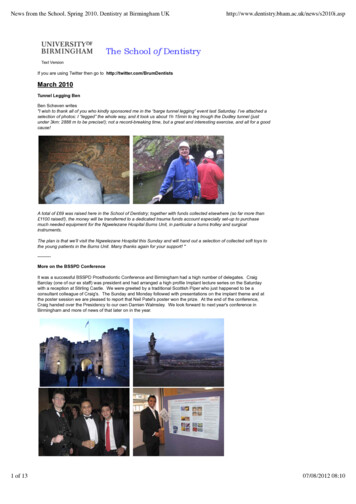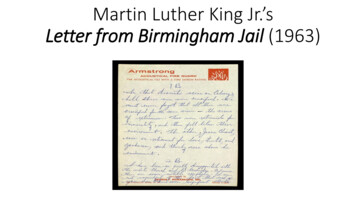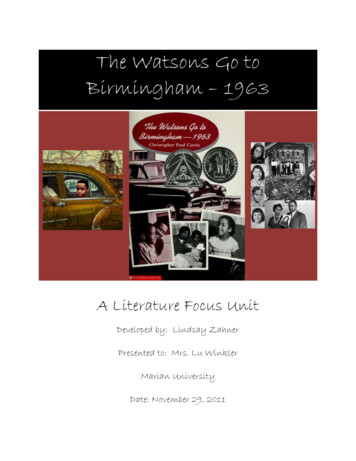
Transcription
The Watsons Go toBirmingham – 1963A Literature Focus UnitDeveloped by: Lindsay ZahnerPresented to: Mrs. Lu WinklerMarian UniversityDate: November 29, 2011
2Table of ContentsPageDescription33456152025263234373843List of themes in the novelList of goals and objectivesBackground KnowledgeVocabulary WordsVocabulary StrategiesComprehension StrategiesGraphic OrganizersDiscussion QuestionsList of Similar BooksReading and Writing ActivitiesPoetryDifferentiated InstructionAssessmentsReferences
3Themes and ObjectivesThemes1. Racism, discrimination, prejudice2. Family3. Bullying4. Growing upGoals/ObjectivesWI AcademicStandard –Social StudiesB.4.4 - Compare and contrast changes in contemporary life with life in the past by lookingat social, economic, political, and cultural roles played by individuals and groups.ClassroomObjectiveI can relate my life with life in the past by comparing and contrasting importantcharacteristics of people in a story.WI AcademicStandard –Social StudiesC.4.1 Identify and explain the individual's responsibilities to family, peers, and thecommunity, including the need for civility and respect for diversity.ClassroomObjectiveI can identify qualities needed to be a responsible sibling, son or daughter, friend, andstudent.CommonCore –LanguageArtsRL.5.2. Determine a theme of a story, drama, or poem from details in the text, includinghow characters in a story or drama respond to challenges or how the speaker in a poemreflects upon a topic; summarize the text.ClassroomObjectiveI can better summarize a story by relating specific story events to the overall theme of thebook.CommonCore eArtsClassroomObjectiveRL.5.3. Compare and contrast two or more characters, settings, or events in a story ordrama, drawing on specific details in the text (e.g., how characters interact).I can better understand a story by comparing two key elements within the text.RL.5.1. Quote accurately from a text when explaining what the text says explicitly andwhen drawing inferences from the text.I can better understand a story by correctly pulling out important events or language.
4Background KnowledgeBackground Knowledge1. Time period 1960’s2. Civil War and the Civil Rights Movement3. Discrimination in the South4. Martin Luther King and Rosa Parks5. Freedom Riders6. 16th Street Baptist Church BombingSee this website for information regarding most of the above:http://www.english.illinois.edu/maps/poets/m r/randall/birmingham.htm
5Vocabulary WordsVocabulary WordMerriam-Webster DefinitionemulateeggheadTo strive to equal or excelIntellectualHaving an eye that is turned or tilted toone sideActing or usually acting at an appointedtime or at a regularly scheduled timeA trancelike stateOf, relating to, or characteristic of childrenor young peopleAid in the form of money or necessities forpeople in needFree in giving or sharingKnowledge of right and wrong and afeeling one should do what is rightA procedure in which the hair of anAfrican-American boy is straightenedthrough the use of potatoes, lye, Vaseline,and soap.1. Swing music or dancing performed to it2. slick, deceptive, or foolish talk: a speciallanguage of difficult or slang termsTo persuade or try to persuade to dowrong by promise of pleasure or gainTo listen secretly to private conversationWater moving rapidly in a circle with ahollow in the center into which floatingobjects are drawnA sound like that of an explosion producedwhen a shock wave formed at the nose ofan aircraft traveling at supersonic speedreaches the erousconscienceconk(Definition retrieved oppedwhirlpoolsonic boomBookLocationPage 24Page 25Page 26Page 28Page 54Page 74Page 76Page 81Page 85Page 87Page 112Page 123Page 128Page 169Page 182
6Vocabulary StrategiesPurpose - the following 3 vocabulary strategies were chosen to introduce, practice and assessthe vocabulary terms. All resources are included with each strategy.Strategy #1 - Introduce the vocabulary terms with Spencer Kagan Round RobinBrainstorming.Definition of Round Robin Brainstorming - Class is divided into small groups (4 to 6) with oneperson appointed as the recorder. A question is posed with many answers and students aregiven time to think about answers. After the "think time," members of the team shareresponses with one another round robin style. The recorder writes down the answers of thegroup members. The person next to the recorder starts, and each person in the group gives ananswer until time is called.Definition retrieved from: ning.htm)Supplies Needed: The Watsons Go to Birmingham – 1963 Vocabulary Packet (next page) Anchor Chart (teacher created vocabulary list for classroom display on wall)o Chart will have three columns – Vocabulary Word, Definition, Picture (if time allows)How it works:1. Teacher splits students into groups of 4 – 6 students appointing the following jobs: Recorder,Reader, Referee, Materials Getter, and Question Master.2. The Materials Getter should retrieve The Watsons Go to Birmingham – 1963 Vocabulary Packetfor their group.3. Students will then Round Robin Brainstorm for each vocabulary word in their packet. Teachershould be circulating groups making sure each student gets a chance to share their responses.4. The Reader should read the vocabulary word and the sentence it is used in.5. The group should then decide on their “best guess” and the Recorder records the group’sdefinition in the vocabulary packet. If group cannot come to an agreement, the Referee willmake the final decision. Groups should work out problems on their own. If any questions arise,the group should try to solve it. If no solution is found, only the Question Master may raisetheir hand and pose the question to the teacher (this should promote interdependence amongthe group and build problem-solving skills).6. Teacher will then go through vocabulary words, one by one, calling on Recorders to share theirgroup’s definitions.7. The teacher will then give the actual definition from the Merriam-Webster Dictionary, compareit to the student response, and record it in “kid-friendly” language on the Anchor Chart with apicture.8. Steps 6 and 7 repeat for each new vocabulary word.
7Group One’s Mystery WordsNames of Group Members:Mystery Word:Sentence:emulateIf, instead of trying to intimidate your young brother, you would emulate himand use that mind of yours, perhaps you’d find things much easier.Definition:Mystery Word:Sentence:Definition:Mystery Word:Sentence:Definition:eggheadBuphead said, “Here that little egghead punk is.”cockeyedByron said “You ain’t cockeyed no more, your eyes is straight as a arrownow!”
8Group Two’s Mystery WordsNames of Group Members:Mystery Word:Sentence:punctual“This is the only way you little punks is gonna learn to be punctual. I hopethat fool has a pleasant walk to school” The bus driver said.Definition:Mystery Word:Sentence:hypnotizedJoey looked like she was hypnotized. Her mouth was open and her eyeswere bugging.Definition:Mystery Word:juvenileSentence:“ I will burn not just one finger, I will burn your entire hand, then send youto a juvenile home!” mom yelled to Byron.Definition:
9Group Three’s Mystery WordsNames of Group Members:Mystery Word:welfareSentence:“I can’t believe it. You really gonna start serving welfare food in this house?Definition:Mystery Word:generousSentence:Then I noticed a crumpled-up Swedish Crèmes bag on the ground next to thetree and I could figure out why he was being so generous. He’d alreadyeaten a bag and a half.Definition:Mystery Word:conscienceSentence:Leave it to Daddy Cool to torture human kids at school all day long and neverhave his conscience bother him but to feel sorry for a stupid little grayishbrown bird.Definition:
10Group Four’s Mystery WordsNames of Group Members:Mystery Word:Sentence:Definition:Mystery Word:Sentence:conkByron had gotten a conk! A process! A do! A butter! A ton of trouble!jiveIf I gotta listen to all this jive I’m gonna go in the house and get some realcool sounds.Definition:Mystery Word:Sentence:Definition:temptationsSo hopefully, the slower pace in Alabama will help him by removing some ofthose temptations.
11Group Five’s Mystery WordsNames of Group Members:Mystery Word:Sentence:eavesdroppedWhen Mrs. Davidson left, Momma went upstairs and into Joey’s room. Ieavesdropped.Definition:Mystery Word:Sentence:whirlpoolIf ya’ll are going to the water you stay away from Collier’s Landing. A coupleof years ago Jimmy got caught up in some kinda whirlpool there and theydidn’t find the poor soul’s body for three days.Definition:Mystery Word:Sentence:Definition:sonic boom“What was that bang?” Dad kept looking toward the sky and said, “Hmm,must have been a sonic boom.”
12Strategy #2 – Provide practice of the vocabulary terms with Vocabulary Think-Tac-ToeDefinition of Think-Tac-Toe: a form of alternative assessment and can be used with all grades and willall subjects. The idea is for students to work in groups and choose three projects to do. The top line issimple, the middle line is a bit more difficult and the bottom line is projects that would take several daysto complete. Students can select their any of the three columns (which would include on project fromeach level), or they could choose either diagonal. Teachers may decide to assign particular projects tothe groups.Definition Retrieved from: http://www.rcs.k12.tn.us/rc/instruction/ttt/about TTT.htmI adapted this version of Think-Tac-Toe to consist of activities at varying levels of BloomsTaxonomy – first row are lower levels, middle row are middle levels, and bottom row arehighest levels of taxonomy. Each activity addresses a different multiple intelligence.Supplies needed: Vocabulary Think-Tac-Toe game board - enough copies for each student (board on nextpage) Readers NotebookHow it works:1. Students should open their Readers Notebook to the Table of Contents and add thefollowing entry into the next available page: “The Watsons Go to Birmingham Think-TacToe”2. Each student should receive a Vocabulary Think-Tac-Toe sheet and tape it into theirReaders Notebook at the next available page assigned in the Table of Contents.3. Throughout the unit, students should practice their vocabulary words by choosing anythree of the options listed on the Think-Tac-Toe board. Activities chosen should make a“tic-tac-toe” by going three horizontal, diagonal, or vertical.4. Activities will be completed in the Readers Notebook on the pages preceding the ThinkTac-Toe board.5. After students complete the activity, they will turn their Readers Notebooks into theteacher for accountability.
13VOCABULARY THINK-TAC-TOEDirections: Below is a Think-Tac-Toe to help you study vocabulary words from The Watsons Goto Birmingham – 1963. Please cut this board out and tape it into your Readers Notebook. Youwill choose 3 activities from the board that go in a straight line; to make Tic-Tac-Toe. Color inthe each box when you have completed it. Complete the activities in your Readers Notebook.When you are finished, turn your notebook into your teacher.Verbal Linguistic KnowledgeCreate an acrostic poem.Choose 5 of your vocabularywords you find the mostinteresting. Write themvertically on your paper.Use the letters in yourvocabulary word to begineach line. Each line shoulddescribe the vocabularyword chosen.Bodily/Kinesthetic ApplicationPerform a dance, skit, orrole-play to dramatize 6 ofyour vocabulary words. Youcan perform this for mewhen you are ready.Interpersonal - SynthesisDesign a lesson plan thatwould teach yourclassmates six of thevocabulary words.Visual/Spatial –KnowledgeDraw a picture that willhelp you define each ofyour vocabulary words.Logical/Mathematical ComprehensionCreate a chart or table tocategorize your vocabularywords in a way that makessense to you (examples couldbe parts of speech, similarmeanings, etc.)Explain your thinking.Naturalist - AnalysisMusical - ApplicationConduct an investigationthat will help you identifya simile for six vocabularywords. A simile is acomparison of two thingsor ideas using like or as.Your investigation caninclude the computer,dictionary, etc.Intrapersonal - EvaluationDevelop a song, rap, or jingleusing 6 of your vocabularywords. You should includedescriptions that help youunderstand the vocabularyword. The vocabulary wordsmust be used in the correctcontext.Rate your vocabularywords in the order of howwell you know them (1being the best and 15 theworst). Create a goalstatement for yourselftelling how you will learnwords 10-15.Create a crossword puzzleusing all the vocabularywords. Your clues must bein your own words. Have 3classmates complete thepuzzle.Interpersonal - Synthesis
14Strategy #3 - Assess the vocabulary terms with Spencer Kagan Quiz-Quiz-Trade.Definition of Quiz-Quiz-Trade - All students stand up and pair up. One student reads thequestion to the other student. The other student answers. The first student corrects, ifnecessary, then gives a praise statement (whether the answer is right or wrong). The studentsswitch roles. When both questions have been given, the students trade questions, and then puttheir hand up. They look around for other students with their hands up, and pair up with newpartners.Definition Retrieved from - hp?t 78901Supplies Needed: Index CardsHow it works:1. Pass out one index card per student.2. Assign each student a vocabulary word. Students should record the vocabulary word on theblank side of the index card and the definition on the lined side of the index card.3. Students pair up.4. Student one shows their definition (lined side) to Student Two. Student Two then gives thevocabulary word. Student one gives a “praise” and, if student two was wrong, gives the correctvocabulary word.5. Student Two then show
29.11.2011 · Each activity addresses a different multiple intelligence. Supplies needed: Vocabulary Think-Tac-Toe game board - enough copies for each student (board on next page) Readers Notebook How it works: 1. Students should open their Readers Notebook to the Table of Contents and add the following entry into the next available page: “The Watsons Go to Birmingham Think-Tac-Toe” 2.
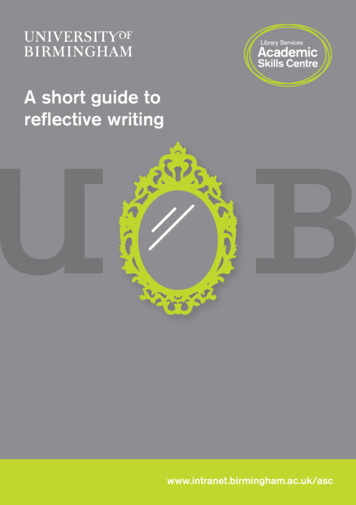
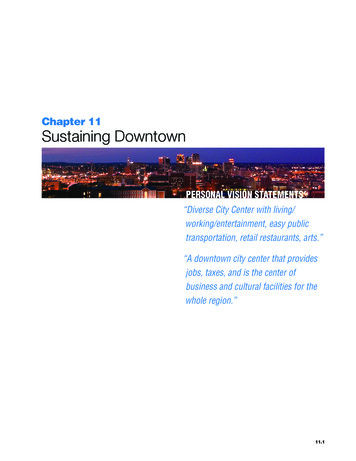

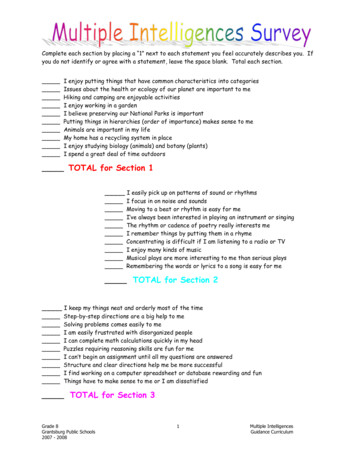
![Letter from Birmingham Jail (1963) [Abridged]](/img/2/1963-mlk-letter-abridged.jpg)
